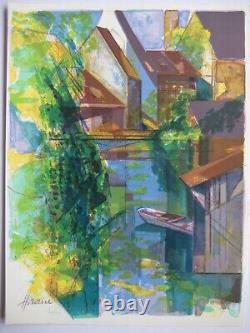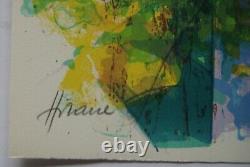
- Index
- Authenticity
- Characteristics
- Genre
- Abstract (92)
- Abstrait (363)
- Art Deco (52)
- Art Déco (109)
- Art Moderne (10)
- Art Naïf (30)
- Art Nouveau (97)
- Cubisme (26)
- Expressionism (53)
- Expressionnisme (162)
- Fauvisme (13)
- Modern (53)
- Moderne (18)
- Naive Art (21)
- Pop Art (40)
- Street Art (62)
- Streetart (87)
- Surrealism (23)
- Surréalisme (103)
- Symbolisme (14)
- Other (1418)
- Style
- Support
- Type
Hilaire Camille Signed Lithograph Rivers Alsace




In the 1970s, the painter Camille Hilaire decided to create works illustrating the rivers of Alsace. Around twenty works were produced titled Reflections on the Lauter, the Lièpvrette, the Largue, the Doller, the washerwoman on the Thur, Lake Lauch, Lauch in Colmar, Lake Altenweier, the confluence of the Weiss and the Béhine, the Weiss in Kaysersberg, fisherman on the Giessen, the Ehn in winter, Andlau, the Ill in Illhauesern, Nideck waterfall, Zorn, Moder, Rhine and Bruche. This lithograph corresponds to one of these illustrations. Original lithograph signed in pencil. Edition: limited to 195 copies.
Condition: see photographs; good; never framed. Free hand delivery possible in Paris by appointment. The work is sold with an invoice and detailed description.
Camille Hilaire, born in 1916 in. Camille Hilaire was born in 1916 in. Coming from a modest background, he first became. Then he started drawing and painting on location. In 1934, he married Anne-Marie Reslinger with whom he had a daughter, Jeannine.
At that time, he frequented the city library to copy. His work was noticed by. Who welcomed him into his painting studio in Metz. Hilaire met the governor of the city, General de Sainte-Croix, who intervened so that he could do his military service in Paris. Shortly after, Camille Hilaire was mobilized and bravely participated in the.
After which he was taken prisoner. He escaped and rejoined Paris in early 1941.
In 1942, he married Simone Jance for the second time. Not wanting to be forcibly incorporated into the German army as. He chose to go into hiding and registered under a false name, Leblanc, at the. During the Occupation years, a student of.
While attending the academy of. With whom he became friends. Who influenced his confident and incisive line, marked by the brightness of the Italian masters, Camille Hilaire began to exhibit at various Parisian Salons. In 1947, Hilaire was appointed professor of drawing and decorative composition at the. National School of Art in Nancy.
A position he held until 1958. Continuing his artistic research, he experimented with new techniques, watercolor, stained glass, and tapestry. He was appointed professor at the. National School of Fine Arts.
In his profession, he then created models for the. Allowing him to travel and exhibit. Hilaire nurtured his talent through these travels, throughout the century, his painted or woven work expresses their beauty and diversity, from Venice to Normandy, which he particularly loved, from. He died at his property in. In Eure (Normandy) and is buried at the.
From his union with Simone Jance-Hilaire, Camille Hilaire had four children: Christiane, Pascale, Claude, a painter known as. And Florence, an artist-painter known as.
And figuration, his works with bright colors are luminous. Camille Hilaire represented the nuanced expression of composition. Thus, starting from effective structures, he held power through color and achieved an admirable and constant sense of calm, magnitude, and grandeur by translating motifs and elements, which never prevented him from expressing a burning passion for creation and sharing.
Remarkable were his nudes with perfect curves, charmingly nestled in an environment where their sensual fullness imposed itself in provocative grace. As for landscapes, Hilaire knew how to dictate their structure without apparent constraint, imbuing them with the fresh, pungent green that often characterized him. Thus, nature and elements became a pretext where the artist pushed color to achieve the desired effect. As for tapestries, all his graphic skills and his desire to seek were merged into splendid works that constantly solicit the eye with their technically successful pure harmony, representing the artist as well as his lithographs, achieving an astonishing outcome.
Church of Sainte-Anne in Nancy. One of the interior walls of the. Georges de la Tour College. Is adorned with a bucolic fresco, impressive in size and beauty, painted by Camille Hilaire. It was preserved during the recent modernization of the building.He also designed stained glass windows for churches. About ten monographs have been dedicated to him, as well as reports and films.
He leaves behind a vast body of work, marked by the seal of seduction, in its most demanding form. Hilaire strongly influenced French painting in the mid-20th century. The Camille Hilaire committee created by his son. Today consists of four founding members (Pascale Hilaire, Florence Hilaire, Christophe Berteaux and Alexandre Gaubert).
This committee is currently the only authority authorized to appraise and issue certificates of authenticity for the artist's works. It is responsible for the integrity and protection of the archives.
